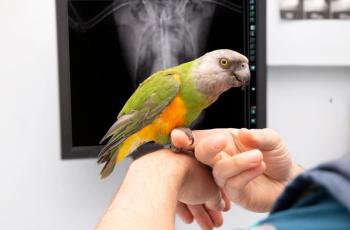
New technology is advancing patient care at Cornell University
Cornell University Hospital for Animals has installed Varian's Edge linear accelerator and a Siemens Naeotom Alpha photon-counting CT scanner to improve outcomes
The Cornell University Hospital for Animals is now using an Edge linear accelerator (Varian) and Siemens Naeotom Alpha photon-counting CT scanner, to enhance therapy and diagnosis for patients. According to the university, the technology is the most advanced of their kind available on the market.1
“It’s important that Cornell stays on the cutting edge of what veterinary medicine has to offer. Installing crucial pieces of technology allow us to increase our patient care offerings and advance the field through research and teaching,” Susan Ruland, interim hospital director, said in a news release.
The Edge linear accelerator provides state-of-the art, noninvasive radiotherapy treatments that delivers a targeted dosage to tumors in areas that include the brain, lungs and spine.1,2 Although approximately 40% of veterinary schools have radiation oncology programs, few have access to such technology, according to Cornell University.
One of the other schools with an Edge linear accelerator is The University of Florida College of Veterinary Medicine (UFCVM), which obtained the technology in 2021 with assistance from a $3 million gift from the Gauntt Foundation. UFCVM reported success with one of its’ first canine patients, Lincoln, soon after the Edge was first acquired.3
Lincoln received radiation treatment with Edge without surrounding tissue damage. The tumor had grown in a place that rendered it difficult to remove.3
Christopher Adin, DVM, DACVS, then-chair of the college’s department of small animal clinical sciences and current executive associate dean of UFCVM, noted the technology was a “game-changer” for patient care.“Lincoln’s case is a great example of a situation where we are now able to target tumors that we previously would have been unable to deliver radiation to successfully,” Adin said in a news release.3
At Cornell University Hospital for Animals, the Edge linear accelerator replaced machinery installed in 2000. According to news report by the university, the Edge fast tracks treatment times—reducing a potential 20-visit radiation series for a brain tumor to 5 over the course of a week, for example. The reduction in time also decreases the time a patient spends under anesthesia, time that a client spends with veterinary appointments, and opens treatment times for other animals in need of medical care.4
Tracy Gieger, DVM, DACVR, DACVIM, clinical professor in the Section of Radiation Oncology at Cornell, noted in the report that the shorter treatment time is because the radiation is more precise, while also mitigating adverse effects to surrounding tissues.“We can essentially sculpt a dose of radiation around normal tissues,” Gieger said in the report, and used a tumor next to an eye as an example. “Basically, the eye adjacent to the tumor would be getting 90% of the dose as well—now, it’s down to 10 or 20%,”4
Other recent upgrades at Cornell University Hospital for Animals also include a Siemens Naeotom Alpha photon-counting CT scanner, which offers increased sensitivity, reduced radiation exposure and more powerful detection.1 “Photon-counting CT is the newest CT technology, with fewer than 50 scanners in clinical use, and this is the first installed in veterinary medicine,” Peter Scrivani, DVM, professor and chief of the Section of Imaging at Cornell, said in the release.
A photon-counting CT functions differently than typical scanners because it can detect and count each individual x-ray photon, which is a tiny particle of electromagnetic energy, according to Cornell. Images with finer details are produced, and the CT can work with the linear accelerator to create a digital surrogate of the patient. For example, if a cat must have multiple treatments, experts can use advanced imaging from the new CT alongside the robotic couch of the linear accelerator to ensure the cat is positioned exactly as it was before.1 “This allows us the kind of precision that’s within half a millimeter, which is crucial when you’re dealing with small patients or tiny tumors,” Parminder Basran, PhD, FCCPM, FAAPM, associate research professor in the Section of Medical Oncology at Cornell, said in the release.
The John and Eloise Turrel Endowment for Veterinary Oncology, the Richard P. Riney Canine Health Center, the Cornell Feline Health Center and donations from the Clays for K9 Cancer Research Benefit all contributed to the bringing both new technologies to Cornell University Hospital for Animals.1,4
References
- Cutting edge veterinary equipment elevates Cornell’s patient care. News release. Cornell University College of Veterinary Medicine. August 8, 2025.
- Edge. Varian. Accessed August 11, 2025.
https://www.varian.com/products/radiosurgery/treatment-delivery/edge - New linear accelerators at UF veterinary college enhances cancer treatment for animals. News release. University of Florida College of Veterinary Medicine. October 26, 2021. Accessed August 11, 2025.
https://ufhealth.org/news/2021/new-linear-accelerator-uf-veterinary-college-enhances-cancer-treatment-animals - Cutting edge veterinary equipment elevates Cornell’s patient care. Cornell University College of Veterinary Medicine. May 27, 2025. Accessed August 11, 2025.
https://www.vet.cornell.edu/about-us/news/20250527/cutting-edge-veterinary-equipment-elevates-cornells-patient-care
Newsletter
From exam room tips to practice management insights, get trusted veterinary news delivered straight to your inbox—subscribe to dvm360.




